Conversation
Kathi Darbar
Contents
History and origin
The Kathi are said to have given their name to the Kathiawar region and to be mythologically descended from the Sura, an ancient race of sun worshipers found in western India. According to their mythological traditions, they are descended from Kush, the son of the Hindu God Ram. Colonial British historians consider the Kathi to be an invading foreign Scythian tribe that settled in the Kathiawar region in the second century BC.[3] During the time of Sikandar's attack on Punjab, Kathis manfully opposed him, in this conflict, he was wounded badly and that wound became the reason of his death. Because of their bravery, Kathis put up the strongest opposition to the Marathas.[4]Present circumstances
The Kathi have two divisions, the Sankhyavat and Auratia. These divisions are hierarchical in nature, with the former considered royalty. There are three clans found among the Sankhyavat namely the Vala,Khachar and Khuman. and Auratiya namely Dhakhada, Varu, Kotila, Patgir, Basiya, Dhadhal,Shekhva,Boricha, Khavad, Gida, Jebaliya, Manjariya, Khada, Mala, Jalu, Babariya, Bhicharia and many more. Strict exogamy is maintained between the Auratia and Sankhyavat. They are found in both Kathiawar and Kutch divisions of Gujarat.[5] Kathi darbar are horse lovers and they have Kathiawari horses, which are known worldwide.[6] It is noted that the Kathi Darbar will never forget an enemy as shown in the proverb "કાળ છોડે પણ કાઠી નહિ" (Time (Death) Forgets But Not Kathi)".People
Devotee of Swaminarayan, Darbar Shri of Gadhada Dada Khachar was born into this caste. The Kathi Darbar community is connected much of the history of Gujarat. Noted warriors such as Jogidas Khuman, Ram Vala, Chapraj Vala and also the saints Aebhalji Vala, Aapa Giga, Danbapu Chalala, Vihalanath Paliyad, Apa Goarkha, Apa Jadara Songadh and Apa Ratabapu Moladi were born into this Kshatriya caste.See also
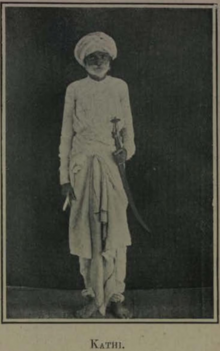
The Kathi people is a small group of clans found in the peninsular Kathiawar (now called Saurashtra) region of Gujarat, western India. It was from the Kathis that the Maratha Empire and later the British Raj named the Saurashtra region as Kathiawar until it was renamed Saurashtra, as the Kathis were prominent there during the 17th-18th centuries. According to A. M. Shah, Kathis are a peasant caste.[1]
Their kuladevatā is the Sun. According to tradition, a Kāṭhī called Vāloji fled from Pāvāgaḍh. He defeated Jām Abdā of Thān with the help of the Sun god, and in return Vāloji repaired the sun temple on Kandolā Hill (originally built by Māndhātā in Satya Yuga). Vāloji's daughter Sonabāi became the priestess of the temple, and married Vālerā Jālu. Sonabāi's descendants, known as Bhagats, form the main sun-worshipping strand of Kāṭhīs.[2]
There are several branches of Kāṭhīs, including Vaḷā, Sakhāyat, Khumān, Khācar, and Auratiya. The Vaḷā Kāṭhīs were formed when a Vaḷā Rājput married a Kāṭhī woman. The Auratiyas were formed on another occasion when Rājputs married Kāṭhi women. Historically, Kāṭhī women were known to marry Rājput men; however, marriages with Āhirs and Bābariās were more common.[3]
The Kathis practiced the partition of territory upon a rulers death, in which his territory would be carved out among his sons. However, the British encourage the practice of primogeniture, in which a ruler's territory would be completely inherited by his eldest son (or whomever was next in succession). The British favored this practice because it was easier to maintain control over a few large states rather than hundreds of small ones. However by the late 1920s, only a few Kathi rulers had adopted primogeniture.[4][5][6] Government of India has added them in Other Backward Class in the central list of Gujarat due to their educational backwardness.[7]
Culture
Kathi people are horse lovers and keep Kathiawari horses, which are known worldwide.[6][need quotation to verify][8]
================================================================================================

A princely state, also called native state (legally, under the British) or Indian state (for those states on the subcontinent), was a nominally sovereign monarchy under a local or regional ruler in a subsidiary alliance with a greater power. Though the history of the princely states of the subcontinent dates from at least the classical period of Indian history, the predominant usage of the term princely state specifically refers to a semi-sovereign principality on the Indian subcontinent during the British Raj that was not directly governed by the British, but rather by a local ruler under a form of indirect rule.
Before the Partition of India in 1947, multiple Rajput and non-Rajput Princely States existed in India which were not part of British India. These were the parts of the Indian subcontinent which had not been conquered or annexed by the British but were subject to subsidiary alliances.
In principle, the princely states had internal autonomy, while by treaty the British Crown had suzerainty and was responsible for the states' external affairs. In practice, while the states were indeed ruled by potentates with a variety of titles, such as Chhatrapati, Maharaja, Raja, Raje, Deshmukh, Nawab, Baig, Khan, Nizam,Mirza or specially Jam for Jadeja/Samma.
| Name | Dynasty | Gun Salutes | Updated |
|---|---|---|---|
| Ajaigarh | Bundela | 11 | 21st Jan, 2023 |
| Ali Rajpur | Rathore | 11 | 30th Nov, 2023 |
| Alidhra | Kathi Kshatriya | - | 31st Aug, 2021 |
| Alipura | Parihar | - | 19th Jan, 2015 |
| Alwar | Kachwaha | 15 | 9th Mar, 2024 |
| Ambliara | Songara Chauhan | - | 3rd Nov, 2023 |
| Amjhera | Rathore | - | 23rd Jul, 2020 |
| Anandpur | Kathi Kshatriya | - | 30th May, 2022 |
| Bagasara | Wala | - | 10th Aug, 2013 |
| Baghal | Parmar | - | 24th Oct, 2023 |
| Baghat | Parmar | - | 20th Aug, 2022 |
| Bakrol | Gohil | - | 6th Jan, 2021 |
| Balsan | Parmar | - | 4th Sep, 2019 |
| Bamra | Gangabasi | - | 25th Jan, 2024 |
| Bangahal | Chandrabansi | - | 16th Mar, 2024 |
| Banka Pahari | Bundela | - | 21st Jun, 2018 |
| Bansda | Solanki | 9 | 8th Dec, 2023 |
| Banswara | Sisodia | 15 | 27th Nov, 2023 |
| Baraundha | Raghuvanshi | 9 | 7th Mar, 2020 |
| Baria | Khichi Chauhan | 9 | 29th Nov, 2023 |
| Baroda | Gaekwad | 21 | 3rd Feb, 2024 |
| Barwala | Wala | - | 9th Sep, 2017 |
| Barwani | Sisodia | 11 | 30th Mar, 2021 |
| Bashahr | Bhati | 11 | 15th Jul, 2022 |
| Bastar | Bhanj | - | 27th Oct, 2023 |
| Beja | Tanwar | - | 9th Mar, 2024 |
| Beri | Parmar | - | 3rd Jan, 2022 |
| Bhadarwa | Baghela | - | 4th Aug, 2020 |
| Bhadawar | Bhadoria | - | 30th Dec, 2023 |
| Bhadrawah | Chandrabansi | - | 28th Jul, 2017 |
| Bhadwa | Jadeja | - | 7th Feb, 2020 |
| Bhajji | Pal | - | 8th Jan, 2020 |
| Bhavnagar | Gohil | 13 | 6th Apr, 2021 |
| Bhayavadar | Wala | - | 12th May, 2023 |
| Bihat | Bundela | - | - |
| Bijawar | Bundela | 11 | 21st Dec, 2023 |
| Bijna | Bundela | - | 21st Dec, 2023 |
| Bikaner | Rathore | 17 | 3rd Feb, 2024 |
| Bilaspur | Chandel | 11 | 3rd Sep, 2022 |
| Bilkha | Wala | - | 10th Feb, 2023 |
| Bonai | Rathore | - | 8th Jan, 2020 |
| Bundi | Hada Chauhan | 17 | 3rd Feb, 2024 |
| Chamba | Mushana | 11 | 12th May, 2023 |
| Changbhakar | Chauhan | - | 15th Dec, 2014 |
| Charkhari | Bundela | 11 | 16th Mar, 2024 |
| Chhaliar | Maharaulji | - | 2nd Oct, 2023 |
| Chhatarpur | Parmar | 11 | 10th Jan, 2019 |
| Chhota Udaipur | Khichi Chauhan | 9 | 27th Mar, 2023 |
| Chital | Wala | - | 22nd Jul, 2014 |
| Chorangala | Khichi Chauhan | - | 3rd Feb, 2017 |
| Chotila | Khachar | - | 9th Oct, 2019 |
| Chuda | Jhala | - | 13th Jul, 2021 |
| Cooch Behar | Narayan | 13 | 15th Jan, 2024 |
| Dangarwa | Dabhi | - | 18th Dec, 2019 |
| Danta | Parmar | 9 | 3rd Feb, 2022 |
| Darkoti | Kachwaha | - | 22nd Jul, 2021 |
| Daspalla | Bhanj | - | 28th Jul, 2017 |
| Datarpur | Katoch | - | 6th Jan, 2023 |
| Datia | Bundela | 15 | 3rd Sep, 2022 |
| Dedhrota | Jhala | - | 24th Aug, 2019 |
| Delath | Suryavanshi | - | 28th Jul, 2017 |
| Deodar | Baghela | - | 3rd Jan, 2022 |
| Dewas Junior | Parmar | - | 3rd Oct, 2022 |
| Dewas Senior | Parmar | 15 | 26th Jul, 2019 |
| Dhadi | Sisodia | - | 23rd Mar, 2018 |
| Dhami | Chauhan | - | 3rd Sep, 2022 |
| Dhar | Parmar | 15 | 20th Nov, 2023 |
| Dharampur | Sisodia | 9 | 19th Mar, 2019 |
| Dhenkanal | Bhuyavamsha | - | 9th Sep, 2021 |
| Dhrangadhra | Jhala | 13 | 26th Feb, 2024 |
| Dhrol | Jadeja | 9 | 15th Mar, 2018 |
| Dungarpur | Sisodia | 15 | 21st Jan, 2024 |
| Gad Boriad | Khichi Chauhan | - | 12th Mar, 2023 |
| Gamph | Chudasama | - | 5th Jun, 2021 |
| Gangpur | Parmar | - | 16th Dec, 2013 |
| Garrauli | Bundela | - | 25th Nov, 2019 |
| Gondal | Jadeja | 11 | 16th Mar, 2024 |
| Guler | Katoch | - | 18th Apr, 2022 |
| Gwalior | Scindia | 21 | 18th Jan, 2023 |
| Hadala-Bagasara | Wala | - | 10th Aug, 2013 |
| Hapa | Parmar | - | 13th Mar, 2019 |
| Hindol | Ganga | - | 5th Feb, 2022 |
| Idar | Rathore | 15 | 26th Feb, 2024 |
| Indargarh | Hada Chauhan | - | 27th Jul, 2021 |
| Indore | Holkar | 19 | 3rd Oct, 2022 |
| Jaipur | Kachwaha | 17 | 26th Feb, 2024 |
| Jaisalmer | Bhati | 15 | 29th Nov, 2022 |
| Jalia Devani | Jadeja | - | 14th Oct, 2021 |
| Jambughoda | Parmar | - | 7th Sep, 2023 |
| Jammu | Jamwal | - | 12th Jan, 2015 |
| Jammu And Kashmir | Jamwal | 21 | 26th Feb, 2024 |
| Jamnia | Songara Chauhan | - | 13th Dec, 2020 |
| Jasdan | Kathi Kshatriya | - | 3rd Jan, 2022 |
| Jashpur | Chauhan | - | 3rd Nov, 2023 |
| Jaso | Bundela | - | 14th Aug, 2022 |
| Jaswan | Katoch | - | 29th Nov, 2022 |
| Jetpur | Wala | - | 8th Jul, 2022 |
| Jeypore | Suryavanshi | - | 16th May, 2021 |
| Jhabua | Rathore | 11 | 21st Jan, 2024 |
| Jhalawar | Jhala | 13 | 3rd Sep, 2022 |
| Jigni | Bundela | - | 4th Apr, 2014 |
| Jobat | Rathore | - | 6th Feb, 2022 |
| Jodhpur | Rathore | 17 | 21st Dec, 2023 |
| Jubbal | Rathore | - | 29th Nov, 2022 |
| Kachhi Baroda | Rathore | - | 1st Feb, 2021 |
| Kadoli | Jhala | - | 16th Apr, 2022 |
| Kalahandi | Naagvanshi | 9 | 24th Oct, 2023 |
| Kangra | Katoch | 11 | 1st Apr, 2023 |
| Kanker | Chandra | - | 24th Sep, 2019 |
| Karaudia | Chauhan | - | 3rd May, 2021 |
| Karauli | Jadon | 17 | 9th Mar, 2024 |
| Kathiwada | Jadon | - | 3rd Jan, 2022 |
| Kawardha | Raj Gond | - | 8th Nov, 2023 |
| Keonjhar | Kachwaha | - | 24th May, 2020 |
| Keonthal | Chandrabansi | - | 24th Nov, 2021 |
| Khairagarh | Naagvanshi | - | 1st Jul, 2022 |
| Khandpara | Baghela | - | 9th Sep, 2017 |
| Khaneti | Parihar | - | 23rd Feb, 2021 |
| Kharedi | Jadeja | - | 21st Aug, 2020 |
| Khari-Bagasara | Wala | - | 7th Apr, 2014 |
| Kharsawan | Rathore | - | 28th Aug, 2023 |
| Khijadia | Wala | - | 4th Apr, 2014 |
| Khilchipur | Khichi Chauhan | 9 | 27th Nov, 2023 |
| Khirasra | Jadeja | - | 11th Feb, 2015 |
| Kishangarh | Rathore | 15 | 29th Jul, 2022 |
| Kolhapur | Bhonsle | 19 | 21st Oct, 2020 |
| Korea | Chauhan | - | 24th Oct, 2023 |
| Kotah | Hada Chauhan | 17 | 26th Feb, 2024 |
| Kotda Sangani | Jadeja | - | 27th Jun, 2018 |
| Kothi | Baghela | - | 1st Apr, 2023 |
| Kotkhai | Suryavanshi | - | 6th Jan, 2021 |
| Krishaniya Estates | Suryavanshi | - | 11th May, 2021 |
| Kumharsain | Parihar | - | 26th May, 2020 |
| Kunihar | Raghuvansi | - | 1st Apr, 2020 |
| Kushalgarh | Rathore | - | 18th Jun, 2021 |
| Kutch | Jadeja | 17 | 23rd Sep, 2023 |
| Kuthar | - | 14th Feb, 2017 | |
| Lakhtar | Jhala | - | 7th Feb, 2020 |
| Lathi | Gohil | - | 27th Apr, 2023 |
| Likhi | Chauhan | - | 17th Jan, 2023 |
| Limbdi | Jhala | 9 | 15th Feb, 2020 |
| Lunawada | Solanki | 9 | 27th Oct, 2021 |
| Maheshpur Raj | Suryavanshi | - | 5th Jun, 2021 |
| Mahilog | Suryavanshi | - | 26th Jul, 2018 |
| Maihar | Kachwaha | 9 | 27th Apr, 2023 |
| Makrai | Raj Gond | - | 2nd Apr, 2015 |
| Malpur | Rathore | - | 8th Nov, 2022 |
| Mandi | Chandrabansi | 11 | 17th Apr, 2023 |
| Mandwa | Khichi Chauhan | - | 27th May, 2021 |
| Mangal | Sen | - | 11th Mar, 2023 |
| Mansa | Chavda | - | 30th Nov, 2023 |
| Mayurbhanj | Bhanj | 9 | 17th Jan, 2024 |
| Mohanpur | Parmar | - | 4th Sep, 2019 |
| Morvi | Jadeja | 11 | 7th Jan, 2024 |
| Mudhol | Ghorpade | 9 | 23rd Mar, 2020 |
| Muli | Parmar | - | 16th Mar, 2024 |
| Multhan | Rathore | - | 9th Nov, 2020 |
| Mysore | Wadiyar | 21 | 3rd Feb, 2024 |
| Nagod | Parihar | 9 | 13th May, 2022 |
| Nagpur | Bhonsle | - | 15th Dec, 2014 |
| Nalagarh | Chandel | - | 17th Jul, 2018 |
| Narsinghgarh | Parmar | 11 | 26th Feb, 2024 |
| Narsinghpur | - | - | |
| Nasvadi | Solanki | - | - |
| Nawanagar | Jadeja | 13 | 7th Jan, 2024 |
| Nayagarh | Baghela | - | 9th Jun, 2021 |
| Nilgiri | Bhanj | - | 3rd Jan, 2022 |
| Nimkhera | Chauhan | - | 20th Aug, 2022 |
| Nurpur | Tanwar | - | 8th Mar, 2022 |
| Orchha | Bundela | 15 | 7th May, 2022 |
| Pal Lahara | Suryavanshi | - | 1st Aug, 2021 |
| Palasni | Parmar | - | 13th Dec, 2015 |
| Palitana | Gohil | 9 | 25th Jan, 2024 |
| Panna | Bundela | 11 | 31st Jan, 2023 |
| Patna | Chauhan | 9 | 7th Jan, 2024 |
| Pethapur | Baghela | - | 6th Jan, 2023 |
| Phaltan | Parmar | - | 8th Apr, 2014 |
| Piploda | Dodiya Rajput | - | 15th Jul, 2022 |
| Porbandar | Jethwa | 13 | 30th May, 2022 |
| Pratapgarh | Sisodia | 15 | 8th Nov, 2023 |
| Punadra | Jhala | - | 7th Feb, 2021 |
| Raigarh | Raj Gond | - | 8th Apr, 2022 |
| Rairakhol | Rathore | - | 24th Oct, 2023 |
| Rajgarh | Parmar | 11 | 2nd Oct, 2023 |
| Rajgarh | Chauhan | - | 28th Jul, 2017 |
| Rajkot | Jadeja | 9 | 3rd Aug, 2023 |
| Rajpipla | Gohil | 13 | 25th Dec, 2023 |
| Ranasan | Parmar | - | 12th Mar, 2019 |
| Ranka | Gaur | - | 17th Apr, 2020 |
| Ranpur | - | 2nd Jan, 2018 | |
| Ratlam | Rathore | 13 | 21st Jan, 2024 |
| Rawingarh | Rathore | - | 17th Mar, 2023 |
| Rewah | Baghela | 17 | 26th Feb, 2024 |
| Sailana | Rathore | 11 | 3rd Feb, 2024 |
| Sakti | Raj Gond | - | 6th Jan, 2021 |
| Sanala | Wala | - | 3rd Jan, 2022 |
| Sandur | Ghorpade | - | 2nd Apr, 2015 |
| Sangri | - | 8th Jan, 2020 | |
| Sanjeli | Chauhan | - | 7th May, 2022 |
| Sant | Parmar | 9 | 28th Apr, 2021 |
| Sarangarh | Raj Gond | - | 26th Jul, 2019 |
| Sarila | Bundela | - | 21st Dec, 2023 |
| Satara | Bhonsle | - | - |
| Sathamba | Solanki | - | 26th Feb, 2024 |
| Savantvadi | Bhonsle | 9 | 20th May, 2020 |
| Sayla | Jhala | - | 25th Jun, 2020 |
| Seraikella | Rathore | - | 8th Jul, 2020 |
| Shahpura | Sisodia | 9 | 13th Mar, 2023 |
| Siba | Katoch | - | 4th May, 2020 |
| Sirmur | Bhati | 11 | 12th Nov, 2021 |
| Sirohi | Deora Chauhan | 15 | 21st Dec, 2023 |
| Sitamau | Rathore | 11 | 29th Nov, 2022 |
| Sohawal | Baghela | - | 28th Aug, 2022 |
| Sonepur | Chauhan | 9 | 20th Jul, 2020 |
| Sudasna | Parmar | - | 10th Sep, 2023 |
| Suket | Chandrabansi | - | 3rd Mar, 2021 |
| Surgana | Parmar | - | 21st Oct, 2020 |
| Surguja | Raksel | - | 9th Mar, 2024 |
| Talcher | Kachwaha | - | 8th Oct, 2021 |
| Tanjore | Bhonsle | - | 6th Jul, 2019 |
| Tehri Garhwal | Parmar | 11 | 14th Jul, 2019 |
| Thana Devli | Wala | - | 12th Feb, 2019 |
| Tharad | Baghela | - | 3rd Jun, 2021 |
| Tharoch | Sisodia | - | 21st Jan, 2024 |
| Tigiria | - | 29th Apr, 2020 | |
| Tori Fatehpur | Bundela | - | 20th Nov, 2023 |
| Tulsipur | Chauhan | - | 6th May, 2019 |
| Udaipur | Sisodia | 19 | 22nd Jan, 2024 |
| Udaipur | Raksel | - | 2nd Feb, 2022 |
| Vadia | Kathi | - | 3rd Jul, 2018 |
| Vala | Gohil | - | 22nd Apr, 2021 |
| Valasna | Rathore | - | 27th Sep, 2019 |
| Varsoda | Chavda | - | 1st Mar, 2020 |
| Vav | Chauhan | - | 11th Mar, 2023 |
| Vijaynagar | Rathore | - | 7th May, 2022 |
| Virpur | Jadeja | - | 29th Jun, 2020 |
| Wadagam | Parmar | - | 29th Nov, 2022 |
| Wadhwan | Jhala | 9 | 7th May, 2022 |
| Wankaner | Jhala | 11 | 9th Mar, 2022 |
GUN SALUTES
A salute state was a princely state under the British Raj during the time of British rule which had been granted a gun salute by the British Crown (as paramount ruler); i.e., the protocolary privilege for its ruler to be greeted—originally by Royal Navy ships, later also on land—with a number of cannon shots, in graduations of two salutes from three to 21, as recognition of the state's relative status. The gun-salute system of recognition was first instituted during the time of the East India Company in the late 18th century, and was continued under direct Crown rule from 1858.
| Salutes | Provinces |
|---|---|
| 21 | Baroda, Gwalior, Jammu And Kashmir, Mysore |
| 19 | Indore, Kolhapur, Udaipur |
| 17 | Bikaner, Bundi, Jaipur, Jodhpur, Karauli, Kotah, Kutch, Rewah |
| 15 | Alwar, Banswara, Datia, Dewas Senior, Dhar, Dungarpur, Idar, Jaisalmer, Kishangarh, Orchha, Pratapgarh, Sirohi |
| 13 | Bhavnagar, Cooch Behar, Dhrangadhra, Jhalawar, Nawanagar, Porbandar, Rajpipla, Ratlam |
| 11 | Ajaigarh, Ali Rajpur, Barwani, Bashahr, Bijawar, Bilaspur, Chamba, Charkhari, Chhatarpur, Gondal, Jhabua, Kangra, Mandi, Morvi, Narsinghgarh, Panna, Rajgarh, Sailana, Sirmur, Sitamau, Tehri Garhwal, Wankaner |
| 9 | Bansda, Baraundha, Baria, Chhota Udaipur, Danta, Dharampur, Dhrol, Kalahandi, Khilchipur, Limbdi, Lunawada, Maihar, Mayurbhanj, Mudhol, Nagod, Palitana, Patna, Rajkot, Sant, Savantvadi, Shahpura, Sonepur, Wadhwan |
AGENCIES
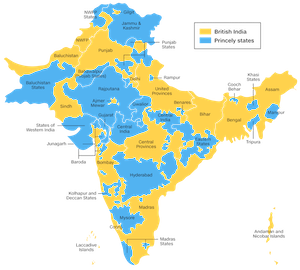
By the time of the departure of the British in 1947, only four of the largest of the states still had their own British Resident, a diplomatic title for advisors present in the states' capitals, while most of the others were grouped together into Agencies, such as the Central India Agency, the Deccan States Agency, Rajputana Agency, etc.
Eastern States Agencies was a political office of the Bengal Presidency of the British Indian Empire and consisted of Orissa States Agency, Chhattisgarh States Agency and Bengal States Agency. Baroda and Gujarat States Agency was a political agency of British India, managing the relations of the British government of the Bombay Presidency with a collection of princely states. Mahi Kantha was a political agency within the Gujarat Division of Bombay Presidency. The Rajputana Agency was a political office of the British Indian Empire dealing with a collection of states northwestern India, under the political charge of an Agent reporting directly to the Governor-General of India and residing at Mount Abu in the Aravalli Range. For administrative purposes Rajputana Agency (Area 330,330 km2) was subdivided into nine groups of states, consisting of three residencies and six agencies:
- Mewar Residency (Area 12,691mi2), with headquarters at Udaipur, dealt with Mewar State (Udaipur).
- Western Rajputana States Agency, which included the states of Banswara, Dungarpur and Pratapgarh. This agency was part of Mewar Residency until 1906, when it was separated.
- Jaipur Residency (Area 15,579mi2), with headquarters at Jaipur, dealt with the states of Jaipur and Kishangarh, as well as the estate of Lawa.
- Western Rajputana States Residency (Area 34,963mi2), with its headquarters at Jodhpur, dealt with the states of Jodhpur, Jaisalmer, and Sirohi.
- Bikaner Agency (Area 23,311mi2), with headquarters at Bikaner, dealt with the state of Bikaner.
- Alwar Agency, with headquarters at Alwar, dealt with the state of Alwar.
- Eastern Rajputana States Agency, with headquarters at Bharatpur, dealt with the states of Bharatpur, Dholpur, and Karauli.
- Haraoti-Tonk Agency, with headquarters at Deoli, dealt with the states of Tonk, Bundi and Shahpura.
- Kotah-Jhalawar Agency, with headquarters at Kota, dealt with the states of Kota and Jhalawar.
Kathi Darbar
The Kathi Darbar (Gujarati: કાઠી દરબાર) is a Kshatriya caste found in Saurashtra region of Gujarat, western India.[1] Kathi Kshatriya are popularly referred as Kathi Darbar.[2]
History and origin
The Kathi are said to have given their name to the Kathiawar region and to be mythologically descended from the Sura, an ancient race of sun worshipers found in western India. Kathi are said to be one of the 36 rajput clan [3] Colonial British historians consider the Kathi to be an invading foreign Scythian tribe that settled in the Kathiawar region in the second century BC.[4] During the time of Sikandar's attack on Punjab, Kathis manfully opposed him, in this conflict, he was wounded badly and that wound became the reason of his death. Because of their bravery, Kathis put up the strongest opposition to the Marathas.[5]
Present circumstances
The Kathi have two divisions, the Sankhyavat and Auratia. These divisions are hierarchical in nature, with the former considered royalty. There are three clans found among the Sankhyavat namely the Vala,Khachar and Khuman. and Auratiya namely Dhakhada, Varu, Kotila, Patgir, Basiya, Bala, Dhadhal, Shekhva, Boricha, Khavad, Gida, Jebaliya, Manjariya, Khada, Mala, Jalu, Babariya, Bhicharia and many more. Strict exogamy is maintained between the Auratia and Sankhyavat. They are found in Kathiawar of Gujarat.[6] Kathi darbar are horse lovers and they have Kathiawari horses, which are known worldwide.[7] It is noted that the Kathi Darbar will never forget an enemy as shown in the proverb "કાળ છોડે પણ કાઠી નહિ" (Time (Death) Forgets But Not Kathi)".
People
Devotee of Swaminarayan, Darbar Shri of Gadhada Dada Khachar was born into this caste. The Kathi Darbar community is connected much of the history of Gujarat. Noted warriors such as Jogidas Khuman, Ram Vala, Chapraj Vala and also the saints Aebhalji Vala, Aapa Giga, Danbapu Chalala, Vihalanath Paliyad, Apa Goarkha, Apa Jadara Songadh and Apa Ratabapu Moladi were born into this Kshatriya caste.
Kathi kshatriya and kathiyawari breed
The Kathi are said to have given their name to the Kathiawar region and to be mythologically descended from the Sura, an ancient race of sun worshipers found in western India.[8] kathiyawari horse derive its name from region kathiyawar. There is no more trustworthy account of the origin of the Kathiwari horse than there is of the Kathi kshatriya themselves.kathi kshatriya have contributed well in development of kathiyawari breed like rathore contribution in development of marwari. It is probable that they brought mares with them when they migrated from the north.The best horse-breeding district is Panchal in the heart, of the province, mostly ruled by kathi kshatriya including Chotila, Paliyad, Anandpur, Bhimora, and Jasdan. Every requirement to successful horse-breeding is found in the PanchAl, favourable soil for the formation of the foot, hilly ground for the development of muscle, running streams of pure water, most nourishing grasses, and a dry and hot climate. From early times this tract has been visited by agents of Rajputana chiefs and others anxious to secure the Kathi blood.[9] so proud are the kathi kshatriya of their horse that they rarely sold them.[10] captain Grant write in his letter that when kathi kshatriya were on outlaw, while outlaws slept their mare watched by their side, and on hearing a suspicious sound tugged at their owner's sleeves, and horses has been favourate theme of their charan singers.[11]kathi kshatriya are known for best horsemanship and horse breeding.Kathi Kshatriya are horse lovers and they have Kathiawari horses, which are known worldwide[12]
Darbar Shaheb Shree Kalubapu Khacher, Taluqdar of Anandpur State , Kathiawar (Gujrat) Dynasty : Kathi Rajput

























.jpg)

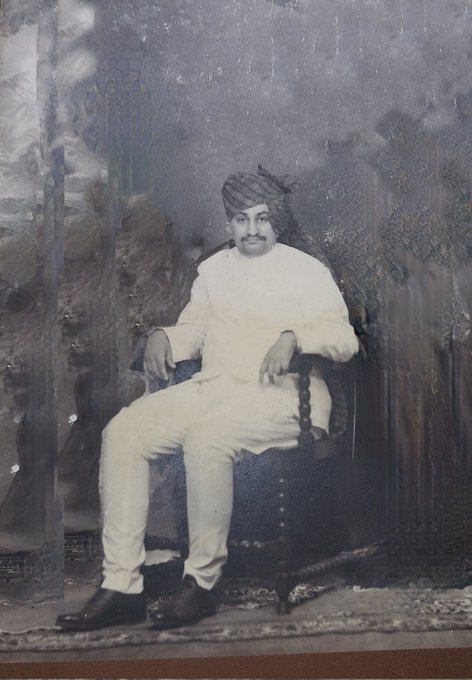


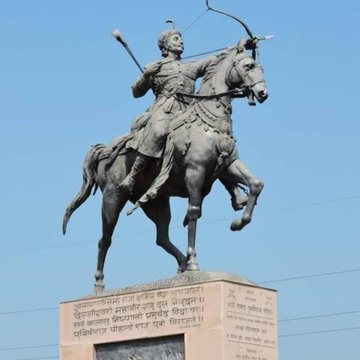


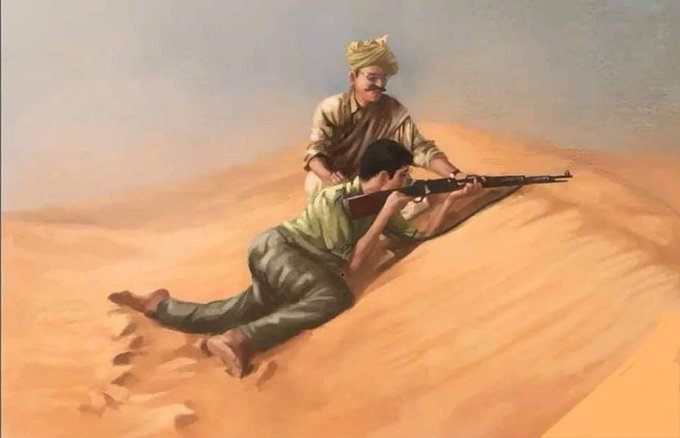

No comments:
Post a Comment